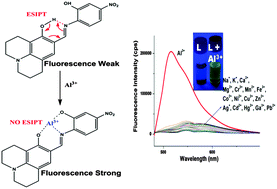Fluorescent sensor for Al3+ ion in partially aqueous media using julolidine based probe†
Abstract
An aluminum selective fluorescent sensor (9-(((2-hydroxy-4-nitrophenyl)imino)methyl)-2,3,6,7-tetrahydro-1H,5H-pyrido[3,2,1-ij]quinolin-8-ol) L was designed and characterised by various techniques such as NMR, IR, CHNS, and UV-Vis. The sensor was proposed for the selective recognition of aluminum and manganese ions in a partially aqueous medium (60 : 40: v/v MeOH/H2O containing 0.001 M HEPES buffer) and had low detection limits of 1.5 μM and 8.1 μM respectively. Sensor L exhibits a large fluorescence response upon binding with Al3+ metal ions. The 1 : 1 stoichiometry of 1 + Al3+ and 1 + Mn2+ was proved by a Job plot.


 Please wait while we load your content...
Please wait while we load your content...